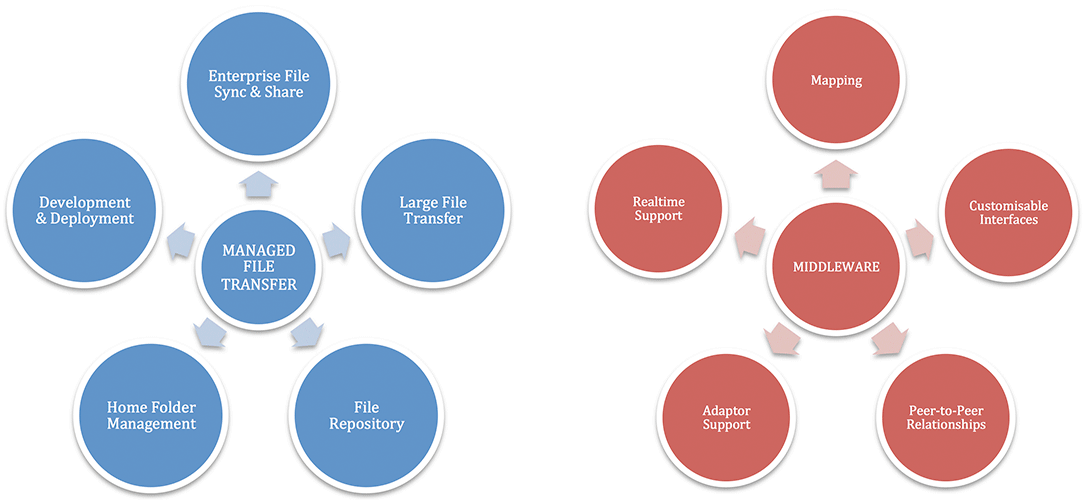Managed File Transfer Versus Middleware
Managed File Transfer and Middleware have both undergone a period of evolution in the past few years. Historically speaking, the early days of both can be easily traced back to the need to move data between various parts of a computer network, generally over simple protocols like FTP or RCP. As a consequence and especially as organisations began to move away from legacy environments, many networks contained an inordinate number of FTP servers, frequently with an unknown array of FTP clients pushing and pulling data in an often uncontrolled fashion.
Middleware stands up…
This became a standard argument for switching to using a middleware product – taking back control of your network and the data that crossed it. Most early middleware systems used a hub and spoke affair and provided a central point where all data would arrive and depart from. Additionally, the notion of data transformation during transit became popular, rather than the more traditional manipulation during processing at source or target system. A ‘code once use many times’ approach appeared for interfaces, allowing for a reduction in development costs, and the only limitation appeared to be the ever-growing range of available connectors.
The beginning of MFT…
FTP servers didn’t go away however; instead organisations began to centralise their FTP sites and a newer smarter generation of FTP server software began to appear. These early versions of Managed File Transfer quickly developed a common set of standard features – encryption, automation, protocol support and user management.
Which is which?
As both middleware and Managed file transfer systems matured, the boundaries between them began to diminish somewhat, with Managed file transfer performing some middleware functions and vice versa. Now we have reached a point where the practical differences have become a little fuzzy, however it shouldn’t be impossible to follow some simple guidelines to decide upon whether an architect should be following a middleware or a managed file transfer approach.
A good starting point is data transformation. Traditionally this falls squarely within the realms of middleware; however there are Managed file transfer solutions which can offer this feature well enough to be considered. In contrast, most middleware does not provide an FTP interface for end-users, relying instead on web services for input or FTP clients for output. An organisation therefore has to review its requirements – do they need an Managed file transfer solution with some middleware functionality, or middleware with some Managed file transfer?

Middleware VS MFT
Further Reading:
While trying to avoid generalisations, here are some things to consider that Managed File Transfer solutions provide and middleware ones generally don’t (or at least not well):
Enterprise File Sync and Share – the process of sharing data by sending a hyperlink via email is not well supported by middleware
Large File Transfer – Very large files are not suitable for transformation and therefore are not often considered by middleware vendors
File repository – Managed file transfer systems normally provide a repository of data for download, often encrypted
Home folder management – mostly, if a middleware system permits users to have home folders, these have to be manually created
Development and Deployment – on the whole, managed file transfer allows for faster design and rollout of interfaces than middleware, which often requires full development teams
Conversely, Middleware can provide functionality that Managed file transfer often struggles with, for example:
Mapping, database lookups and transformation – middleware supports complex mapping operations, either custom or using internationally recognised templates.
Customisable interfaces – middleware provides a framework for development, meaning bespoke designs can be implemented.
Peer-to-peer relationships – generally only available in specialised Managed file transfer products (using agents for example), peer-to- peer interfaces are becoming more popular, especially when making use of cloud technology.
Adapter support – most middleware products provide adapters which allow connections to just about any kind of system. Managed file transfer systems are generally limited to a handful of transfer protocols
Realtime support – with the exception of AS2 transfers, most MFT transfer products are not well suited to synchronous transfers, whereas middleware will generally handle synchronous transfers without problem
In Summary
When considering simple automation, large file transfers or user initiated transfer, Managed File Transfer is better suited than middleware. When looking to introduce complicated interfaces, message transformations or realtime processing, consider using middleware.
The best solution however must come when there is a symbiosis of the two; traffic passes through a Managed file transfer system and is handled by the middleware product. From an automation perspective the flexibility of Managed File Transfer represents a tactical solution, whilst more persistent interfaces are developed using middleware.
If your company is considering implementing a system for securely exchanging data and integrating it into your internal network, you’ll need to know whether the features you require are provided by the leading managed file transfer solutions, or middleware systems. Download our free managed file transfer comparison guide, which provides an ‘at a glance’ list of features and much more:
Further Reading:

Take the risk out of selecting an MFT solution with our free, independent comparison service!
Our comparison report identifies the right solution for your needs and budget. Complete a series of questions and receive a bespoke product recommendation from our technical experts.
